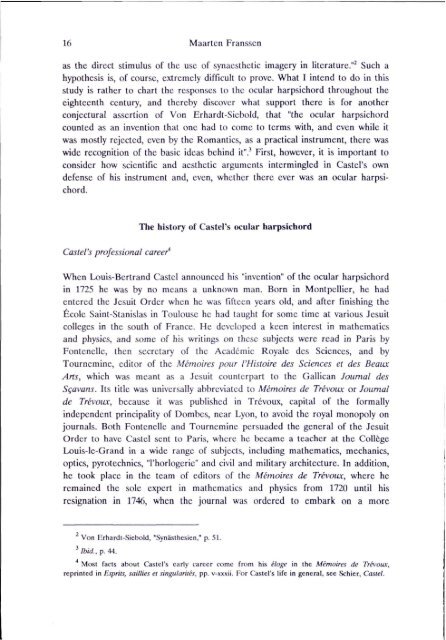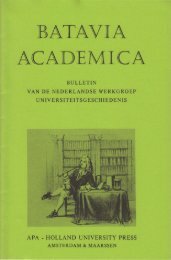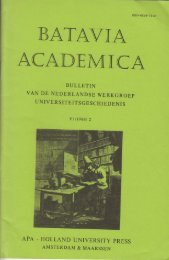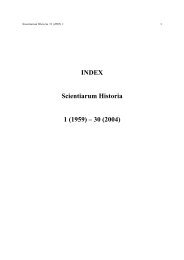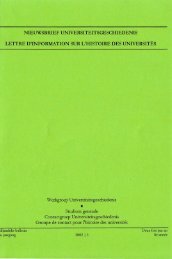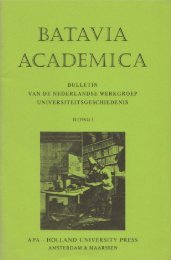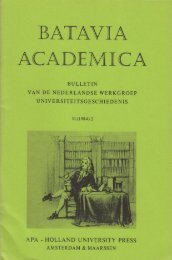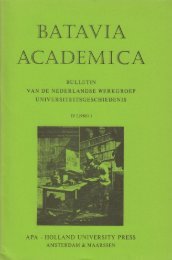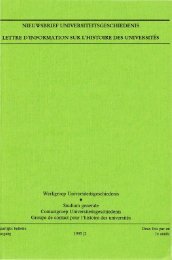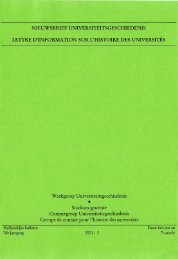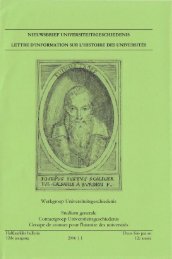the ocular harpsichord of louis-bertrand castel - Gewina
the ocular harpsichord of louis-bertrand castel - Gewina
the ocular harpsichord of louis-bertrand castel - Gewina
Create successful ePaper yourself
Turn your PDF publications into a flip-book with our unique Google optimized e-Paper software.
16 Maarten Franssen<br />
as <strong>the</strong> direct stimulus <strong>of</strong> <strong>the</strong> use <strong>of</strong> synaes<strong>the</strong>tic imagery in literature."^ Such a<br />
hypo<strong>the</strong>sis is, <strong>of</strong> course, extremely difficult to prove. What I intend to do in this<br />
study is ra<strong>the</strong>r to chart <strong>the</strong> responses to <strong>the</strong> <strong>ocular</strong> <strong>harpsichord</strong> throughout <strong>the</strong><br />
eighteenth century, and <strong>the</strong>reby discover what support <strong>the</strong>re is for ano<strong>the</strong>r<br />
conjectural assertion <strong>of</strong> Von Erhardt-Siebold, that "<strong>the</strong> <strong>ocular</strong> <strong>harpsichord</strong><br />
counted as an invention that one had to come to terms with, and even while it<br />
was mostly rejected, even by <strong>the</strong> Romantics, as a practical instrument, <strong>the</strong>re was<br />
wide recognition <strong>of</strong> <strong>the</strong> basic ideas behind it".' First, however, it is important to<br />
consider how scientific and aes<strong>the</strong>tic arguments intermingled in Castel's own<br />
defense <strong>of</strong> his instrument and, even, whe<strong>the</strong>r <strong>the</strong>re ever was an <strong>ocular</strong> <strong>harpsichord</strong>.<br />
Castel's pr<strong>of</strong>essional career*<br />
The history <strong>of</strong> Castel's <strong>ocular</strong> <strong>harpsichord</strong><br />
When Louis-Bertrand Castel announced his "invention" <strong>of</strong> <strong>the</strong> <strong>ocular</strong> <strong>harpsichord</strong><br />
in 1725 he was by no means a unknown man. Born in MontpcUier, he had<br />
entered <strong>the</strong> Jesuit Order when he was fifteen years old, and after finishing <strong>the</strong><br />
fecole Saint-Stanislas in Toulouse he had taught for some time at various Jesuit<br />
colleges in <strong>the</strong> south <strong>of</strong> France. He developed a keen interest in ma<strong>the</strong>matics<br />
and physics, and some <strong>of</strong> his writings on <strong>the</strong>se subjects were read in Paris by<br />
Fontenelle, <strong>the</strong>n secretary <strong>of</strong> <strong>the</strong> Academic Royale des Sciences, and by<br />
Tournemine, editor <strong>of</strong> <strong>the</strong> Memoires pour I'Hisloire des Sciences el des Beaux<br />
Arts, which was meant as a Jesuit counterpart to <strong>the</strong> Gallican Journal des<br />
Sqavans. Its title was universally abbreviated to Memoires de Trevoux or Journal<br />
de Trevoux, because it was published in Trevoux, capital <strong>of</strong> <strong>the</strong> formally<br />
independent principality <strong>of</strong> Dombes, near Lyon, to avoid <strong>the</strong> royal monopoly on<br />
journals. Both Fontenelle and Tournemine persuaded <strong>the</strong> general <strong>of</strong> <strong>the</strong> Jesuit<br />
Order to have Castel sent to Paris, where he became a teacher at <strong>the</strong> Coll6ge<br />
Louis-le-Grand in a wide range <strong>of</strong> subjects, including ma<strong>the</strong>matics, mechanics,<br />
optics, pyrotechnics, "I'horlogerie" and civil and military architecture. In addition,<br />
he took place in <strong>the</strong> team <strong>of</strong> editors <strong>of</strong> <strong>the</strong> Memoires de Trevoux, where he<br />
remained <strong>the</strong> sole expert in ma<strong>the</strong>matics and physics from 1720 until his<br />
resignation in 1746, when <strong>the</strong> journal was ordered to embark on a more<br />
Von Erhardt-Siebold, "Synas<strong>the</strong>sien," p. 51.<br />
'/bid., p. 44.<br />
Most facts about Castel's early career come from his eloge in <strong>the</strong> Memoires dc Trh'oiix,<br />
reprinted in Esprits, saillies et singularites, pp. v-xxxii. I"or Ostel's life in general, see Schier, Castel.


